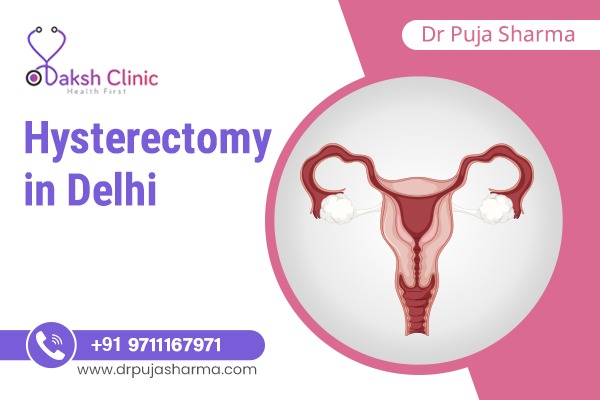Hysterectomy in Delhi
What is a hysterectomy?
The uterus is an important part of a women’s reproductive system that acts as a nurturing zone to the newly developing baby. Apart from this, it helps women retain their fertility and regulate healthy menstruation. Sometimes,due to various problems in the uterus (commonly called the womb), it's removal may have to be considered. This surgical procedure of removing the uterus is called Hysterectomy.
Why is a hysterectomy performed?
A hysterectomy is a surgery performed by the surgeon for various reasons. Some of the reasons are:
- Fibroids or non-cancerous growths in the uterus can cause excessive bleeding, pain, etc.
- Uterine prolapse, a condition where the uterus slides into the vaginal canal from its usual position.
- Endometriosis, where the uterine lining grows beyond the uterine cavity.
- Abnormal bleeding
- Pelvic Inflammatory diseases (bacterial infections) can cause chronic pain in the abdominal region.
- Adenomyosis, a condition where the endometrium grows inside the muscular walls of the uterus.

Hysterectomy in Delhi can be considered for the above reasons when other treatment options did not prove to be helpful or successful. Connect with Dr Puja; her team of experts will guide you throughout. Dr Puja’s clinic is considered the best for Hysterectomy in South Delhi.
Hysterectomy is also considered in cases of cancer of the uterus, ovaries, or cervix.
What are the types of Hysterectomy?
The surgeon can remove the uterus completely or partially which again depends on its condition. Depending on the part of the uterus removed hysterectomy can be categorized as below:
- Supracervical or partial hysterectomy: This type of hysterectomy is done to remove only the upper portion of the uterus and the cervix is kept intact
- Total hysterectomy: This type of hysterectomy is done to remove the whole part of the cervix and the uterus region.
- Radical hysterectomy: Here the entire uterus and the tissues on the sides of the uterus, cervix, and upper vaginal region are also removed. Radical hysterectomy is generally considered in cases of cancer of the uterus, ovaries or cervix.
- Oophorectomy: A hysterectomy done to remove the ovaries along with the uterus.
- Salpingectomy: Surgery performed to remove the fallopian tubes along with the uterus.
- Hysterectomy and bilateral salpingectomy-oophorectomy: Surgery performed to remove the uterus, fallopian tubes, and the two ovaries.
Benefits/ Advantages of Hysterectomy
While we understand the types of Hysterectomy, knowing its advantages can help make a better choice.
It can surely improve the quality of life. It is known to relieve various symptoms such as vaginal bleeding, pelvic pain caused due to various infections, cancerous and non-cancerous conditions.
Hysterectomy Complications
Hysterectomy is relatively a safe procedure with no serious risks or complications. However, some of the very few complications include:
- Heavy Bleeding during or after the procedure
- Infections and injury to the surrounding organs or tissues
- Trouble during urination
- Urinary incontinence
- Vaginal prolapse ( the vagina comes out of the body)
- Vaginal fistula formation (a connection between the vagina, bladder, or rectum)
- Abdominal pain after the surgery
Hysterectomy Procedure
There are two major approaches to hysterectomy that a surgeon suggests depending on the condition of the uterus and overall health status. They are:
- Traditional/ Open surgery Hysterectomy: One of the most common approaches is an open surgery hysterectomy. In this procedure, the surgeon makes a 5- to 7-inch incision across the belly to remove the uterus.
- Minimally invasive Hysterectomy: This type of hysterectomy involves a small incision in the vaginal opening. This incision can help remove the uterus. This is also called a vaginal hysterectomy.
- Laparoscopic aided Hysterectomy: Here, a small device with a camera and high beam light called a laparoscope guides the surgery. The laparoscope is inserted through the vagina or the small incisions made below the navel region. The surgeon will remove the uterus and the affected area with the help of images obtained via laparoscope. Sometimes, even a robot-assisted laparoscopic hysterectomy procedure is considered.
Recovering from a Hysterectomy
Recovery from hysterectomy depends on the extent of incision created to remove the uterus and the healing of the wounds.
- For an abdominal hysterectomy, 2-3 days of extended hospital stay would be recommended.
- In minimally invasive and laparoscopic hysterectomy, since small cuts are made; the incisions can heal faster, are less painful with shorter hospital stays, and lower the possibilities of infection.
Menopause is what is to be expected after a hysterectomy. If the ovaries are removed in the process, menopause begins and if the ovaries are retained, you will attain menopause much before the actual age.
Post surgery care is necessary to avoid complications. Take rest, avoid lifting heavy objects and restrict rigorous exercising post-surgery.
Why choose Daksh Clinic for hysterectomy?
Hysterectomy is known to improve and cure symptoms of different conditions of the uterus. Daksh clinic believes in treating specific requirements of every woman and tailoring the procedure according to the condition.
Dr Puja Sharma, the best gynecologist in Delhi along with the panel of specialists will provide you with the best approach to hysterectomy. The Clinic also offers you an affordable surgical procedure cost of hysterectomy in Delhi.
Consult Daksh Clinic in South Delhi for the most cost-effective, comfortable, and satisfactory surgery of the uterus.
